Personalization at Scale with Paul Jones
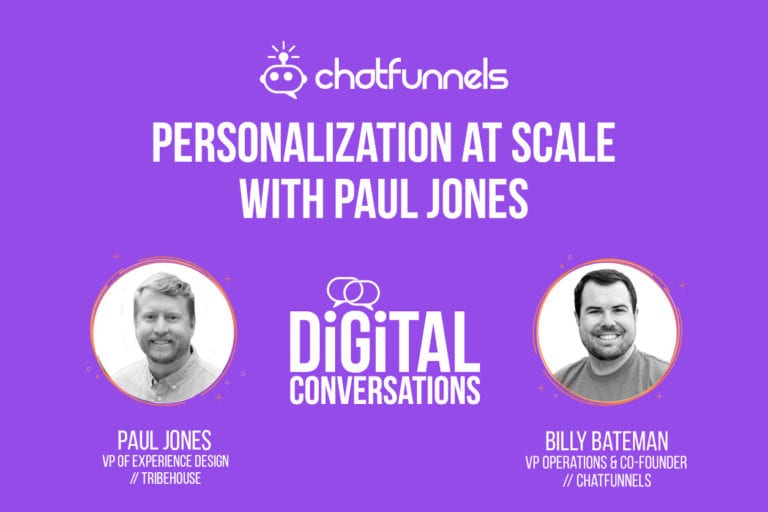
Guest: Paul Jones- Paul Jones is the Vice President of Experience Design at Tribehouse. He is focusing on building experiences that allow executives along the Wasatch Front to connect with other executives and solve problems authentically. He has been a business owner himself and is currently the founder of a tech startup.
Overview: This week we feature Paul Jones VP of Experience Design for Tribehouse. He talks about personalization at scale, how to build a list focusing on common characteristics and using a multi-channel strategy.
Billy: All right, everybody. Welcome to the show today. I’m joined by Paul Jones, VP of experience design at Tribe House. Paul, thanks for joining us.
Paul: Billy, it is so good to be with you today. And thanks for having me.
Billy: Yeah, we’re excited for it. So, today we’re going to talk about using personalization at scale. But before we really hop into the mid of it, tell us a little bit about yourself and a little bit about Tribe House?
Paul: Sure. So, what we do at Tribe House is we build tribes, a tribe to us as any peer to peer group. So, we build professional tribes and then we connect those tribes. We bring those tribes into the tribe house or into our location, and we provide an experience that helps our tribe members network together and build better relationship.
So, our professional tribes consist of, we have a CTO tribe, a CMO tribe, CFO tribe, I mean, the list goes on and on, executive tribe, a B2B tribe. So, any professional tribe that shares a role or a common characteristic, we go out, we find people that are in that. We actually recruit into that tribe. I recruit people into that tribe. It’s free to join one of our professional tribes.
And then when you come to one of our events, you sit down with other CMOs or other CFOs and you get the chance to interact with them, and really kind of brainstorm solutions to problems that you might be facing. So, it’s really fun. It’s a really unique experience.

My job is to help with the process of recruiting into our tribes. I also facilitate a lot of the events and we kind of helped with Designing the experience journey for all of our tribe members, so that would be from the recruiting process all the way to the post event follow up process. And how do we automate that? How do we make it as personal as possible? All of those questions are things that I impact.
Billy: Awesome, man. And then what’s your background in? How’d you get into it?
Paul: Well… You know, what’s funny is, I guess I’m somewhat of a convert to relationships. I come from a startup world. I’ve started my own businesses, then also got into the tech space for a while. And I was really kind of that guy that was a go getter. I mean, I would just steamroll whoever was in my way to get my initiatives done. And so, I got burned enough times to realize that relationships matter extremely. I mean they matter. They’re one of the most important things to your success. And so, how I got involved with Tribe House is that I started going to their events, and I started networking with people and meeting some really amazing people helping me kind of change my perspective, helping me with a lot of the issues that I was facing and scaling up a company scaling up teams.
And from there, I thought, this is awesome, more people need to be impacted by this kind of an experience. And so, I jumped in. So, most are coming from entrepreneur, entrepreneur type background in tech companies. And yeah, getting involved in Tribe House has been awesome, just helping them with that part of it, but also being able to meet really cool people.
If you ever get a chance to read the book, “The Go Giver”, that was where things really changed for me, you go from a go getter to a go giver and kind of trying to lead a more abundance mindset. Kind of what we try to harbor at the tribe house is facilitate more of an abundance mindset for all of our attendees.
Billy: Yeah. Awesome. I’m with you on you get what you give, man. You got to be willing to give that.
Paul: That’s right. Yeah. 100%.
Billy: Okay, man. So, before we get into our main topic, I have one more question for you. So, if we’re going to go look up Paul Jones on social media and try to figure out who you are, what is one thing that I wouldn’t be able to figure out by looking you up on Facebook, or Instagram, or Twitter?
Paul: Okay, well, you’d kind of have to look at the ads that are on my Facebook to figure that out, I think. But let’s see here. There is a story. And when I was in college, I knew at some point in my life, I was going to get married, but I also knew that I had no money, and there was no way I was going to be able to afford a ring.
And there was the local company, it was a local jewelry store that was putting on a race competition and it was like a costume, 5k race and the Best Costume got to win a diamond, a $3,000 diamond. And I remember reading that ad and I was like, I’ve got to win this because otherwise, my future wife is going to be really disappointed in what she ends up getting for a ring.
So, I built this amazing costume. I built this car out of pine and it was this elaborate multi week project and then it came up for the race. And the night before, I got incredibly sick, like there was no way I was going to be able to run this 5K. And so I went to my roommate and I said, hey, roommate, do you mind running this race for me? I think we have a really good chance of winning this diamond all pitch in. And if we end up winning this diamond we’ll split it or something.
But anyway, he ends up running the race, we end up winning the costume contest and he was on TV and he got interviewed. I mean, it’s all out there on the internet, but it was all my dear from the beginning. And it’s so funny because we actually end up calling that diamond the blood diamond because we couldn’t figure out to… how do you split a diamond? I mean, it’s carbon, right? You can’t split the diamond and now.
Billy: Yeah.
Paul: Anyway, he got all the glory and I didn’t get any of the fame on that one.
Billy: So, what did you guys do with the diamond? Did you upon it, or what did you do?
Paul: No, it’s actually in my wife’s ring right now.
Billy: Okay, so you got it?
Paul: I got it, yeah. But it went through a couple of hands. So literally, I gave it to a buddy. I ended up, we were going down on a climbing trip down to Arizona and I was driving my buddy’s car and we hit a block and ended up rolling it like three times and I felt so bad. So, I gave him the diamond as payment for, hey, I’m sorry, I messed your car up. And he kept it for a few months, then he gave it back because he didn’t feel good about it. And then I ended up having to buy my roommate out. Anyway, there was a lot of drama around that thing.
Billy: But you got it, man, that’s all that counts.
Paul: That’s right. That’s right.
Billy: You got a wife last I knew, so…
Paul: That ended up happening much later, so that worked out too.
Billy: Yeah, man. Okay, well, let’s get into it, enough party cake. So Paul, we started talking about this. He said, I want to talk about personalization at scale. So, let’s just start at the beginning of the foundation. So, what is personalization in marketing?
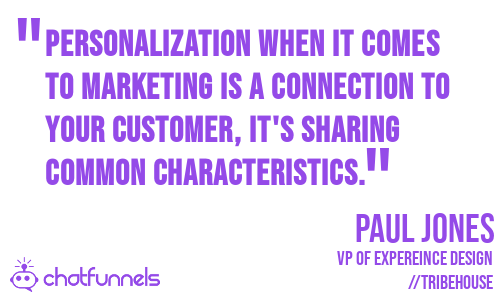
Paul: Well, I can tell you, it’s not a variable field. We’re kind of quite past that. It’s not adding someone’s name into an email campaign. I think it goes much beyond that. For me, personalization in general, when it comes to marketing is, it’s connection to your customer, its sharing common characteristics.
So, those common characteristics with your potential customer, it could be combining these multiple characteristics and creating a relevant message that you deliver to that customer. Basically, what you’re doing is you’re building a case about why your message to them is relevant. And the case that you’re presenting is those common characteristics that you share. So, like a good example is, not all characteristics are created equal.
Billy: Yeah.
Paul: Right? So, at the bottom of the hierarchy, you’re going to start with surface level characteristics; where you live, where you’re at in your life, a millennial, a baby boomer, where you might work, that’s getting a little bit past the surface. But those are some characteristics you can utilize. If you want to move up in that hierarchy, you would be getting into what your potential contacts, customer, or what their potential hobbies are. What problems they’re trying to solve.
And then at the very top of common characteristics is who, who you share together. So, who do you have in common? Who do you know in common? what networking groups are you a part of what? What people groups do you share? What people groups are there overlaps with? And so being able to say, okay, I want to identify these common characteristics that our product, or that our service, or that our event is going to share and then communicate those common characteristics to a single person, that to me is more personalized.
Billy: Okay. Yeah, that totally makes sense. So, how do you do that at scale though? Because I can go and look people up one at a time on LinkedIn or zoom info, figure out who I know or what we have in common. But I mean, no nobody got time for that.
Paul: Yeah, it can get hard. I mean, I’m always impressed when I get a LinkedIn message when someone says, hey, I… Rather than saying, hey, I checked out your LinkedIn profile, they mentioned multiple specific things.
Billy: Yeah.
Paul: But like you said, that’s really hard to do. So, I think it really comes down to your ability to build lists. Personalization at scale, at least in our experience, because we’re an event company. Personalization at scale for us is, you kind of have to take a step back. And there are some things that are going to be a little bit slower, that take a little bit more time. But I think 70% of it, you can still move through pretty efficiently.
So generally, for me, you start with… obviously you start with your list. And for me, my general rule of thumb is, I identify at least three common characteristics that you share with the potential subgroup of customers that you’re going to start to message or that you’re going to start to engage with. Then you build your messaging around those characteristics, and you build your automation around that.
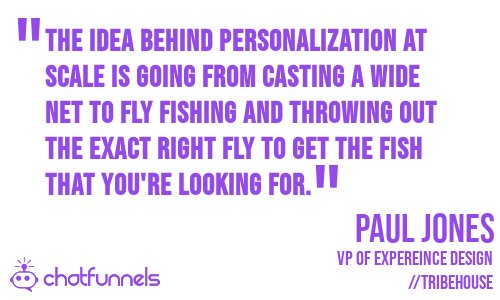
But those three common characteristics, you identify and then you go and you build your list. And you can use LinkedIn Sales Navigator for that. That’s really great. You can use zoom info. You can really drill down into that. I think the idea behind personalization at scale is going from casting a wide net to fly fishing, and throwing out the right exact fly to get the fish that you’re looking for.
Billy: Yeah.
Paul: And so, what does that look like? So, for us, once you have that list, that list is not going to necessarily be what you’re used to. It’s not going to be thousands of people. It might be hundreds of people. But then once you’ve got that list, you’ve got your messaging, you put them into the same play that you would normally play.
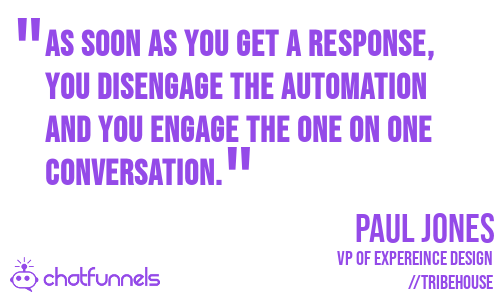
Where the difference though is that, so you’re putting them into your funnel with a bottom of the funnel being a response. And as soon as you get a response, you disengage the automation and you engage the one to one conversation. And that’s where I think things start to slow down a little bit.
So for example, we did a lot of tests where we would try to automate scheduling a demo or scheduling a phone call with calendula. And we’d say, hey, to make things easy, let’s set up a phone call together. And the difference in conversion was incredible. Our open rates were really high. Our reply rates were really high. But we weren’t getting engagement that we needed and things were just dropping off at that invitation. And so we changed it.
We made it more of a manual process. And it became, hey, I’d love to schedule a call with you. I’d love to chat sometime. When would be a good time to talk about this. And it takes a little bit more of work. Because when they reply back, you go into that one to one engagement, but our conversion rates were incredibly high. So, that’s what I’m saying. When you go from a big net down to fly fishing, your list isn’t going to be as big, but your conversion rate changes quite a bit.
Billy: Yeah. It makes sense. We all get the emails. It’s like, hey, let’s set up a time. It looks like we’re a great fit. And I’m like, I don’t know who you are. And I’m not that interested in what you’re selling. I’m going to block you, you know? We all get them in our inbox.
But with the more, like, hey, when I’ve responded, and I don’t know if they’re doing the same thing you’re talking about, but It’s much more personalized on a cold email to get me to do something if I’m actually going to respond. So it makes sense, man. So what tools are you using for this?
Paul: Well, that’s the other thing too is, when your list is smaller and your message is highly personalized to a small subgroup, you want to make sure that you’re getting the inbox. And so we use email platforms that actually send emails from your own server so that’d be like outreach or reply to do that. It’s super nice, you can set up sequences and you can set up some sequences based off of clients or contacts not responding.
We use text messaging as well. The one thing that I’ve noticed is, when you go into that, once they respond and you have to, at that point, engage on that one to one conversation, that manual process right there, that person, the person determining what the next step needs to be on our side has to easily move that person into the next list or into the next bucket. And so, we do a lot with Xavier, lot with Xavier integrations into different campaigns, different things like that.
So, whereas, I think a lot of people out there are probably used to automating that whole journey. We jumped in on the manual side, and we’ve decided. For us, the conversion rate is massive, so it’s worth it for us to jump in and do that manual part.
Billy: Yeah.
Paul: I already mentioned that we do use Sales Navigator for that. We also use zoom info, so a couple other things. But those are primarily the biggest tools that we use.
Billy: So just to recap, you’re using zoom info and a Sales Navigator to build the list? And then like an outreach or reply to actually execute the email sequences?
Paul: Yep, yeah. And we’ll throw…. Well, it’s multi-channel for us, so we’ll throw in text messaging. And the other thing is, when it comes to personalization, there’s some things that you can do that are going to take more time, and there’s some things that you can do that are quite efficient. So, another example that we use is we get on the phone and we call. And what’s interesting about that is you’re leaving a message.

So, when you’re doing a multi-channel strategy, it feels more personal because it’s not just the single email chain that someone’s receiving; you’ve tried to text you tried to call. And then the one thing that can’t talk to enough is the way you position the phone call or the content that you’re presenting to them. And it all comes back to those common characteristics that you share. Because remember, you’re building a case as to why it makes sense to maybe get on a call now, why you think it does.
Billy: Yeah.
Paul: So, we do a lot of phone calls. And those phone calls are nice because you can get on that list. You already know who you’re talking to, and so your message isn’t just, hey, Billy, I think you might be interested in my product. It’s, hey, Billy, I did some research. I chose you for this reason. If it makes sense, let’s chat. So, the multi-channel strategy is a big one for us.
Billy: I agree, man. So, for anybody, before we wrap up, what’s your one piece of advice for somebody that’s thinking about trying to play like this? What would you direct them to do for their first play?
Paul: I think it depends on the product. The piece of advice I would have is, just dive in. When I first started doing this, I remember… My goal was multi-channel, so I’m sending out cards, we’re doing phone calls. We were trying to figure that whole thing out. And I think that’s a really good place to start.
Funny story on that one is, we were building our CMO tribe, and I had worked with a local company to send out a card that was an invitation to join the tribe to our subgroup. I had put in a variable field, I’d given them the list, and we were on such a time crunch that I didn’t test the card. And so, I sent out 300 invitations, and all of my CMOs got high bracket name bracket. And you know what’s funny is, when you send that out to a bunch of marketers, they’re going to laugh, because we’ve all gone through that pain before.
Billy: Yeah.
Paul: So, it was kind of funny because it ended up working in our favor. Because it was going to marketers. They totally got it, and understood and it became kind of this running joke that helped us. It really helped us connect with that group a little bit more. I mean, some people were like, wow, nice job, guys. But other people were like, oh, this is hilarious.
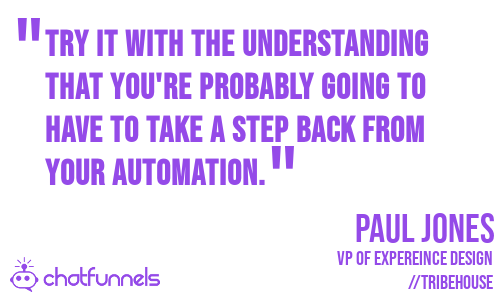
My biggest thing is, just get in there and try it with the understanding that you’re probably going to have to take a step back from your automation. And if more on the personal side, and then your thought process would be, how do I make moving people along more efficient? Not necessarily, how do I get people scheduled more efficiently? Because any of those things kind of are a flag that, hey, this is an automated message.
Billy: Yep, for sure. Okay, man. Well, this has been good. Thanks for hopping on, for sharing the knowledge. If people want to get a hold of you and continue the conversation, or learn more about Tribe House, what’s the best way for them to reach out?
Paul: Sure, yeah. You can reach out. You can message me on LinkedIn. That’s no problem. Or email me at paul@tribehouse.us
Billy: Okay, man. Well, thanks again, Paul. And we’ll chat later.
Paul: All right. Thanks, Billy.
